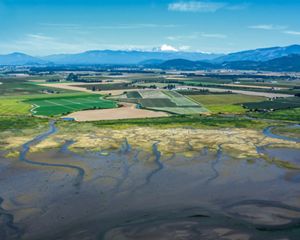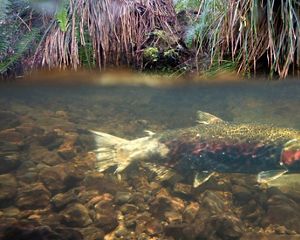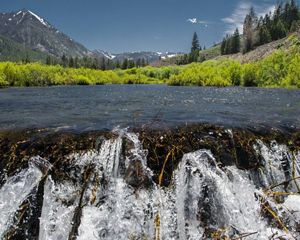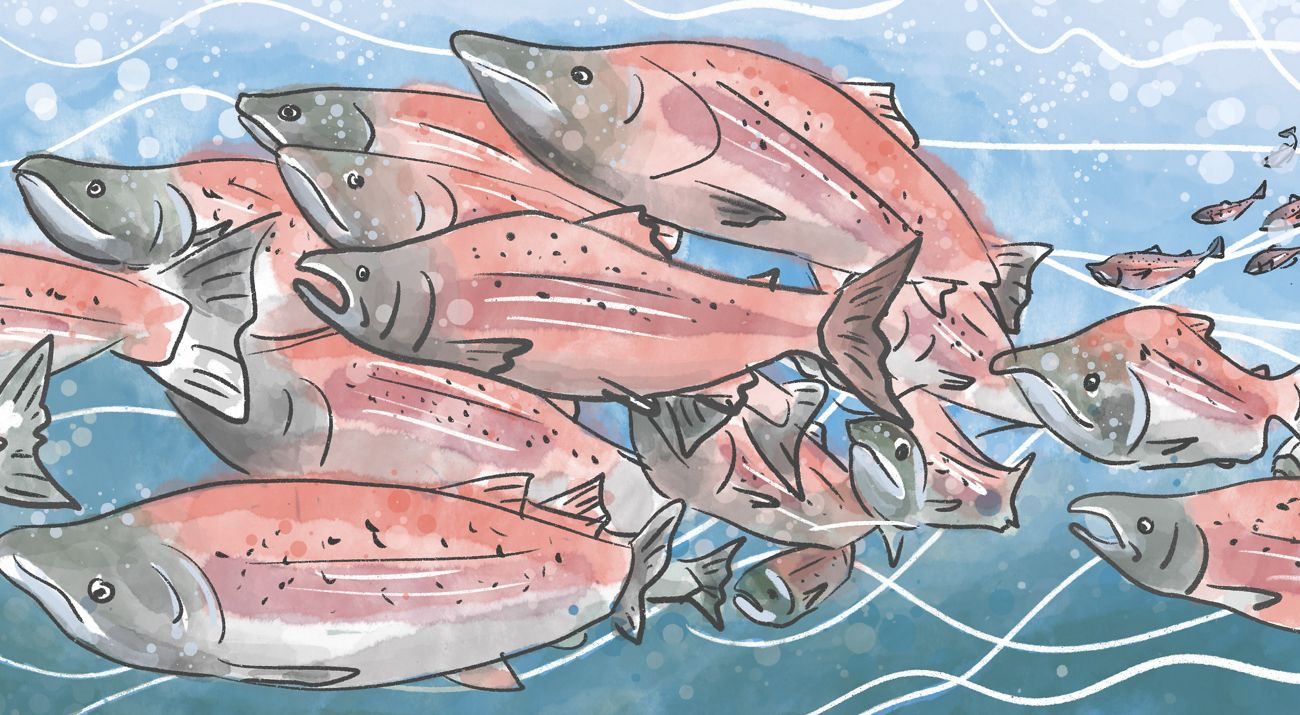
Made of Salmon
Our lives and ecosystems are interwoven with salmon. Protecting them benefits much more than fish alone.
Illustrations by Erica Simek Sloniker/TNC
Salmon are inextricably linked to our way of life, the health of our natural systems and communities across the West. From the ocean, back to the waters of their birth, wild salmon make an inspiring journey that sometimes covers more than a thousand miles. Along the way, they deliver nutrients and high-quality protein on which nearly 140 species of plants and animals depend.
Beyond the miles traveled, salmon tell a powerful story of connection. From nourishment to culture, our lives and ecosystems are interwoven with salmon. If we lose them, we lose far more than fish. If we help them recover, we strengthen the invisible threads that connect all living things.
Wherever there are salmon, people come together to celebrate what they symbolize and what they provide. We marvel at their might, and appreciate their ability to sustain our traditions and our livelihoods. Wild salmon connect the land and water, showing us that caring for the land plays a key role in how we care for our waters. These are stories of our relationship with salmon.
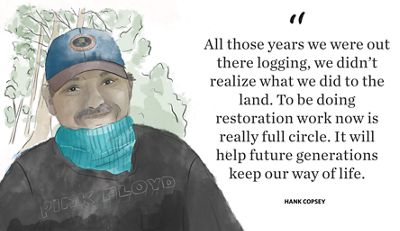
Caring for Salmon is Indigenous Tradition
After the heydays of old-growth logging in the coastal rainforest of Alaska’s lush Tongass National Forest, a lot of salmon streams weren’t faring so well. Some were left cut off by logging roads and their fish-blocking culverts. Streams once sheltered by goliath trees got warmer and faster.
The changes were harming baby salmon’s chances at survival. And here, where families tend smokehouses to put up their harvest for the year, people were alert to all the ways salmon were struggling. Repairs were needed, and soon, help was on the way.
Speak Up for Nature
At our Online Action Center, ask Congress to act and defend Bristol Bay!
Take ActionSupport from The Nature Conservancy and others has enabled huge areas of the forest to be managed for community needs, like gathering food, while elevating Indigenous stewardship.
Hank Copsey spent his early adulthood in the timber industry in Kake, Alaska. When the local industry collapsed, Kake’s population plunged, and jobs grew scarce. It was time to think differently about the future of forest. Now, Copsey leads Keex’ Kwaan Community Forest Partnership in Kake, restoring salmon streams and the surrounding forest, and supervising a crew of young local guys, most of them new dads.
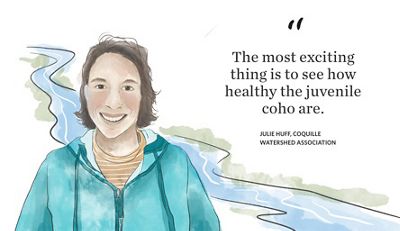
Salmon Get Help from Working Farms
On the Oregon coast, the Coquille delta means so much to so many. Farming is a way of life here, a place where agricultural bounty anchors the local economy. Natural wonders like birds and fish abound, yet not as they once did. Populations of Coquille River coho salmon, for one, aren’t so abundant anymore—a hard truth on the Oregon coast. Since 2008, Oregon’s threatened coho salmon have had Endangered Species Act protections.
Finding the common ground to bring coho salmon back takes tremendous community will. It also means asking the right questions and doing the science—seeing the problems, creating solutions, and relentlessly tracking progress. These efforts can work, and they’re restoring water flows on the Coquille delta at places like Winter Lake. Farming and salmon are both coming out ahead thanks to restored streamside forests and smart changes in how the flow of water is controlled.
So far, in these restored habitats, the youngest coho salmon are leaving these renewed tidelands and estuaries in better shape and fit for the journey ahead. That’s heartening, because for a growing salmon, the ocean calls.
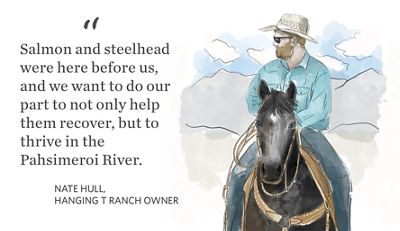
Migrating Salmon Go Upstream—and Far
The Pahsimeroi River meanders through a mile-high valley in Idaho known for working ranches. For hayfields. For mule deer and pronghorn, too, and wintering herds of elk. The Pahsimeroi River, with its source near Borah Peak, Idaho’s highest point, may feel far from the Pacific Ocean. And at 900 river miles away, it is far. Yet this clear-flowing stream is one of the very important places where Chinook salmon can get a start in life. That’s especially critical today, because Snake River Chinook, listed as threatened under the Endangered Species Act more than three decades ago, are in trouble.
Even if there’s no simple fix, wherever salmon live there are ways to turn things around. This is why TNC coordinates with partners and ranchers like Nate Hull. The Hull family runs the Hanging T Ranch where they are implementing restoration projects that will improve conditions for adult salmon returning to spawn. Restoring lands and waterways along the Pahsimeroi River helps to keep water flowing clean and cold, and adds to ongoing efforts in the Pacific Northwest to help Chinook salmon return in bigger and better numbers.
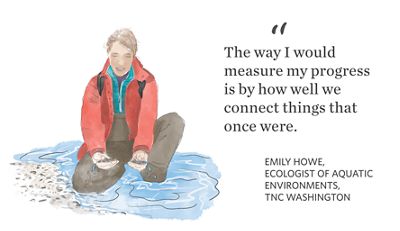
Science. Then Action.
For a salmon, the Stillaguamish delta at the edge of the Salish Sea is a place in between. While one end of a salmon’s journey reaches far out into the Pacific Ocean, the other end stretches upstream into mountain forests. Yet the Stillaguamish delta in Washington State is more than a halfway point between the snowy peaks of the Cascade Range and the Gulf of Alaska’s far-off ocean gyres. It’s an estuary. Estuaries are places of mixing, where salmon transition from the freshwater of the river for the saltwater of the sea—and back again.
Healthy estuaries are like safe harbors for baby salmon, offering the food they need to grow strong enough to survive a long journey to the ocean. But estuaries all over the world are also places where people have built dikes to push back the sea and levees to confine the rivers, making space for everything from cities to farm fields. And so like many others, the Stillaguamish delta is a changed estuary. This is why scientists like TNC’s Dr. Emily Howe are reconnecting life-giving tidal and river flows across estuarine deltas like the Stillaguamish. Over the next few years, the Stillaguamish Tribe of Indians, a sovereign federally recognized tribe, and TNC will reconnect a network of marsh channels across TNC’s 4,000-acre Port Susan Bay Preserve and nearly 800 newly acquired acres by the Tribe, providing young Chinook salmon with an abundance of new places to feed.
Yes, Chinook salmon in the Stillaguamish River and beyond, as a species, face a tough comeback journey. Bringing life back to the estuary is one of the ways we’re working together to give them a fighting chance.
Make Your Connection to Nature
Sign up to get our latest conservation news and learn how you can get involved.

